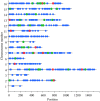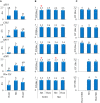Genes with a Combination of Over-Dominant and Epistatic Effects Underlie Heterosis in Growth of Saccharomyces cerevisiae at High Temperature
- PMID: 27200081
- PMCID: PMC4854886
- DOI: 10.3389/fgene.2016.00072
Genes with a Combination of Over-Dominant and Epistatic Effects Underlie Heterosis in Growth of Saccharomyces cerevisiae at High Temperature
Abstract
Heterosis describes a phenotypic phenomenon of hybrid superiority over its homozygous parents. It is a genetically intriguing phenomenon with great importance for food production. Also called hybrid-vigor, heterosis is created by non-additive effects of genes in a heterozygous hybrid made by crossing two distinct homozygous parents. Few models have been proposed to explain how the combination of parental genes creates an exceptional hybrid performance. Over-dominant mode of inheritance is an attractive model since a single gene can potentially create the heterotic effect, but only a few such loci have been identified. To a collection of 120 hybrids, made by crossing 16 divergent Saccharomyces cerevisiae yeast strains, we applied a method for mapping heterozygous loci that non-additively contribute to heterotic growth at 37°. Among 803 candidate loci that were mapped, five were tested for their heterotic effect by analyzing backcrosses and F2 populations in a specific hybrid background. Consistently with the many mapped loci, specific analyses confirmed the minor heterotic effect of the tested candidate loci. Allele-replacement analyses of one gene, AEP3, further supported its heterotic effect. In addition to over-dominant effects, the contribution of epistasis to heterosis was evident from F2 population and allele-replacement analyses. Pairs of over-dominant genes contributed synergistically to heterosis. We show that minor over-dominant effects of multiple genes can combine to condition heterosis, similarly to loci affecting other quantitative traits. Furthermore, by finding of epistatic interactions between loci that each of them individually has an over-dominant effect on heterosis, we demonstrate how hybrid advantage could benefit from a synergistic combination of two interaction types (over-dominant and synergistic epistatic). Thus, by portraying the underlying genetic complexity, these findings advance our understanding of heterosis.
Keywords: QTL; epistasis; genetic interaction; hybrid vigor; over-dominance; quantitative traits; yeast.
Figures




References
LinkOut - more resources
Full Text Sources
Other Literature Sources
Molecular Biology Databases
Miscellaneous

